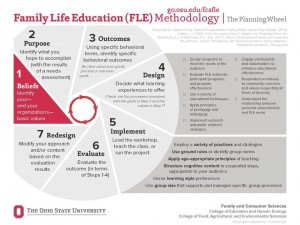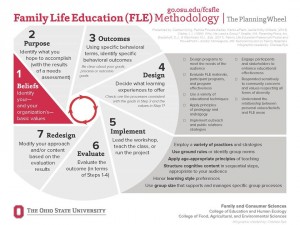Updated 2022 to include resources for OSU Extension colleagues:
- General Expectations – OSU Extension A&P Educator Levels
- Handout, Family Life Educator Content Areas, Worksheet for Family and Consumer Sciences Examples
- Links shared in CFLE PPT
- Requirements to Become a CFLE www.ncfr.org/cfle-certification/become-certified
- Your Toolkit to Promote Family Science, Download Free Resources to Spread the Word About Family Science www.ncfr.org/about/what-family-science/toolkit
- Elevate FCS Toolkit www.aafcs.org/elevatefcs
- Marketing Products to Recruit FCS Educators: If life is a lab, who are the instructors? Family and Consumer Sciences Educators are. www.fcsed.net/recruit/recruit-marketing
- Family Life Education Methodology: The Planning Wheel (infographic useful in planning programs) osu.edu/fcsfle
- Family Life Education Framework, Across the Lifespan (infographic useful for those interested in learning more about CFLE) osu.edu/fcsfle
- Colleagues – you are invited to read the three Suggested Readings (below) Reconceptualizing the Domain and Boundaries of Family Life Education (2011) and Family Life Education: A Profession with a Proven Return on Investment (ROI) (2014) and The Family and Consumer Sciences Body of Knowledge and the Cultural Kaleidoscope: Research Opportunities and Challenges (2009)
- See bottom of this page for links on Patrice and FLE work
From student presentation, 2020:
(one-page student Handout_CFLE in workplace . All information on handout is listed below)
- What helps you?
- Who helps you?
- Who do you help?
Suggested Readings:
Myers-Walls, J. A., Ballard, S. M., Darling, C., & Myers-Bowman, K. S. (2011). Reconceptualizing the domain and boundaries of family life education. Family Relations, 60, 357-372. www.ncfr.org/sites/default/files/domains_article_fr.pdf
Kirby Wilkins, J., Taner, E., Cassidy, D. & Cenizal, R. (2014). Family Life Education: A profession with a proven return on investment (ROI). National Council on Family Relations, white paper. www.ncfr.org/sites/default/files/ncfr_white_paper_family_life_education.pdf
Nickols, S., Ralston, A., Anderson, C., Browne, L. Morgan, Schroeder, G., Thomas, S., Wild, P. (2009). The Family and Consumer Sciences Body of Knowledge and the Cultural Kaleidoscope: Research Opportunities and Challenges. Family and Consumer Sciences Research Journal, Vol. 37, No. 3, March 2009 266-283 https://higherlogicdownload.s3.amazonaws.com/AAFCS/82f10d53-1c37-4fa4-a958-92fa0ea974be/UploadedImages/About/BOK-Nickols.pdf
Organizations:
- Ohio State University Extension extension.osu.edu (Cooperative Extension, a non-formal educational outreach provided by the state’s designated land-grant universities)
- National Council of Family Relations ncfr.org (professional organization and also provides the CFLE credential)
- Where are Family Life Educators Employed? https://www.ncfr.org/cfle-certification/what-family-life-education/where-are-family-life-educators-employed
- Ohio Council on Family Relations (state affiliate of NCFR)
- American Association of Family and Consumer Sciences video: aafcs.org/about/about-us/what-is-fcs/what-is-fcs-video
- National Extension Association of Family and Consumer Sciences
Tools:
- All Kinds of Families (artwork) com/en/blog/diverse-families/
- Family Life Education Methodology: The Planning Wheel (infographic useful in planning programs) osu.edu/fcsfle
- Family Life Education Framework, Across the Lifespan (infographic useful for those interested in learning more about CFLE) osu.edu/fcsfle
- Mindfulness
- Three Senses Mindfulness Activity https://blissfulkids.com/three-senses-mindfulness-activity-kids-teens-grown-ups/
- Mindfulness Idea Starter, cpb-us-w2.wpmucdn.com/u.osu.edu/dist/b/7275/files/2020/08/Mindfulness-Ideas-and-Activities.pdf
Other Links (related to the class presentation):
- Promoting CFLE – these NCFR pages have quotes from CFLEs about their experience:
- Share your suggestions/experience as a CFLE here: https://www.ncfr.org/ncfr-report/winter-2019/marketing-cfle-credential-collaborative-effort
Other links (related to Patrice’s certification)
- Careers in Family Science Booklet, NCFR (Powers-Barker on page 34-35)
- Meet the Board, OHCFR , 2018, Powers-Barker





